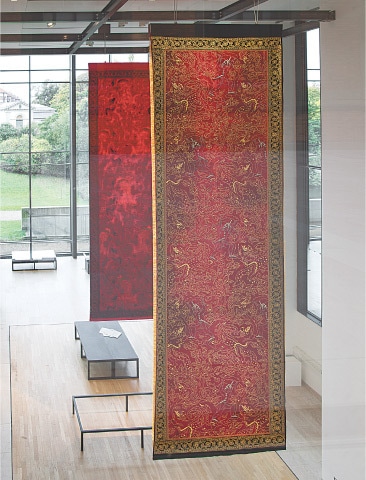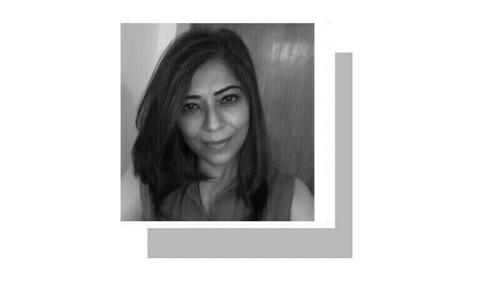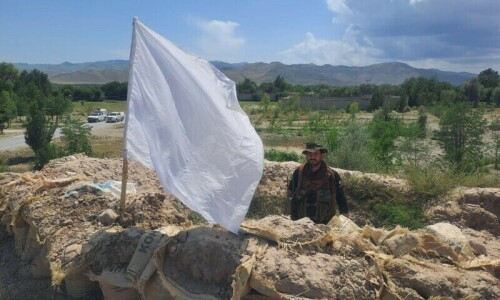Art audiences can devour in 70 of Aisha Khalid’s most significant works in multiple venues an opportunity to experience the art of one of Pakistan’s most celebrated contemporary artists. This comprehensive retrospective titled ‘I Am and I Am Not’, sponsored by HBL and spanning 28 years of Khalid’s practice, showcases the diversity of her aesthetics, as they evolved since graduation in miniature art from the National College of Arts, Lahore, in 1993.
Curated by Masuma Halai Khawaja, the survey includes an eclectic display of architectural tapestries hung from the majestic elevated ceilings of the gothic interior at Frere Hall, embroideries, quilts, video works, drawings, paintings and objects.

With the main body of work at the Frere Hall, Chawkandi Art Gallery is showing the earliest work of the artist — her known gouache on wasli paintings such as ‘Realms of Another God’ (1996), the series ‘Zunaira Ke Naam’ (1996) when she started to incorporate the double frame in a single work, and smaller paintings from 2000 showing the duality of line and flora that have evolved in later work into complex portals to abstract and spiritual dimensions.
The AAN Gandhara Art Space and Museum is showing more of the overtly political work from paintings that introduced the camouflage design post-9/11, from the early to mid-2000s.
A tapestry commissioned for the Moscow Biennale, titled after Tolstoy’s ‘Time and Patience’ (2013), with the rose motif embroidered in silk thread and steel needles on white muslin, covers the gallery floor. This work was dedicated to the weavers in Bengal whose practice suffered after the Industrial Revolution. Khalid dismisses the Western hierarchies that have separated ‘art’ and ‘craft’, as having created divisions of class.
A grand multi-venue retrospective of one of Pakistan’s most celebrated contemporary artists, Aisha Khalid, comes to Karachi
The organisational credit goes to Karachi’s foremost commercial gallery, Chawkandi Art Gallery, from where many established artists, including Aisha Khalid and her contemporaries in neo-miniature, launched their careers. No doubt, this is a befitting tribute to Khalid at the prime of her career.
It is a greater honour for Khalid, in what appears in her words to be a “two-person show” with the late luminary, Sadequain, whose iconic mural is finally being cleaned and protected against the ravages of environmental pollution and consistent neglect by the municipalities.

The scale and magnitude of Sadequain’s iconic last mural ‘Al-Ardh-o-was-Samawat’ (The Earth and the Heavens, 1976) housed in the main hall is bound to take the audiences’ breath away. Imagine the prolific Sadequain, frail and of ill health, spending night and day painting his most ambitious project, a work left incomplete due to his untimely death.
Khalid, who grew up revering the master, has indicated her wish to “complete” his mural, just as the color blue has been added to the ceiling post-Sadequain. Though Khalid’s idea has not materialised in the way she had conceived it, she began to read connections between their works, as she installed her work in proximity to his.
The stark line in Khalid’s few calligraphic paintings seem to speak directly to the heavens and the universe, portraying the connection to the Creator. Perhaps, it is the quest for a higher order in their respective contexts that draws them closer in conversation.
Sadequain, the self-taught, self-proclaimed ‘faqir’, negates his own self in his frenzied yearning for a higher order, to lift a broken human spirit. Khalid locates herself in the quiet rhythm of poetic nuances situated in Eastern thought, losing herself in its repetitive meditative rhythm.

She looks towards cohesion, instead of feeding on the rhetoric of rupture addressed by most of her contemporaries. In many ways, Sadequain seems to “complete” Khalid, for she turns away from colonial constructs, seeking refuge in the circle of devotion.
Khalid’s large-scale painted diptychs, triptychs and qua-diptychs titled, ‘I Am and I Am Not’ (2020), serenade the skies, as we look up in rapture at her flight into the vortex of the unknown. These abstract spaces look to infinity, anchored in the crossover of grids, and intersecting lines and patterns. She paints a luminous blue sky in a four-panel work referencing Surah-e-Feel, in which the weakest of birds, the Ababeel (Martin), with stones in their beaks, are sent by Allah to defend against a battalion of elephants.
One panel of an ‘army’ of elephants is drawn in the traditional siyah qalam [black pen], but enlarged manifold from its original context of Pahari miniature painting. Elephants, tigers, falcons and birds in Khalid’s recent work appear from the same source and, to her, they represent bravery and resilience.
The falcon, for example, is the same one drawn by the Mughal painter Abul Mansur for emperor Jehangir’s tomb. Khalid enlarges it in painstaking siyah qalam, renewing the link to the traditional master, but within her own social context. Drawing by hand becomes an act of devotion.
There is a fearlessness in Khalid that she recalls coming from her childhood in Shikarpur. She watched her father as he crafted a beautiful dagger by hand that he gifted to her just days before his death in 2018. She had posted an Instagram shot of the father teaching her how to use a bow and arrow in memory of the strength he imparted in her.
Under the watchful eye of Sadequain (through his work on the ceiling) there are large painted panels of an army of swords minus the figures. This army of swords creates its own rhythm, which you can hear if you allow yourself to. This then, is the inner world of the artist, her imagination requiring no boundaries of the material world. She absolves herself, the body, abandoning the figurative, in a flight where she is and she is not.
‘I Am And I Am Not’ opens on November 28 and runs through January 8, 2022, at the Frere Hall, Chawkandi Art Gallery and the AAN Gandhara Art Space and Museum in Karachi
Published in Dawn, EOS, November 21st, 2021
















































Dear visitor, the comments section is undergoing an overhaul and will return soon.